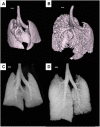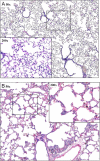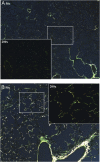Tumor necrosis factor-alpha overexpression in lung disease: a single cause behind a complex phenotype
- PMID: 15805183
- PMCID: PMC2718479
- DOI: 10.1164/rccm.200410-1349OC
Tumor necrosis factor-alpha overexpression in lung disease: a single cause behind a complex phenotype
Abstract
Rationale: Tumor necrosis factor alpha (TNF-alpha) has been implicated as a key cytokine in many inflammatory lung diseases. These effects are currently unclear, because a transgenic mouse overexpressing TNF-alpha in the lung has been shown in separate studies to produce elements of both emphysema and pulmonary fibrosis.
Objectives: We sought to elucidate the phenotypic effects of TNF-alpha overexpression in a mouse model.
Measurements: We established the phenotype by measuring lung impedance and thoracic gas volume, and using micro-computed tomography and histology.
Main results: We found that airways resistance in this mouse was not different to control mice, but that lung tissue dampening, elastance, and hysteresivity were significantly elevated. Major heterogeneous abnormalities of the parenchyma were also apparent in histologic sections and in micro-computed tomography images of the lung. These changes included airspace enlargement, loss of small airspaces, increased collagen, and thickened pleural septa. We also found significant increases in lung and chest cavity volumes in the TNF-alpha-overexpressing mice.
Conclusions: We conclude that TNF-alpha overexpression causes pathologic changes consistent with both emphysema and pulmonary fibrosis combined with a general lung inflammation, and consequently does not model any single human disease. Our study thus confirms the pleiotropic effects of TNF-alpha, which has been implicated in multiple inflammatory disorders, and underscores the necessity of using a wide range of investigative techniques to link gene expression and phenotype in animal models of disease.
Figures







Comment in
-
Combined pulmonary fibrosis and emphysema: an experimental and clinically relevant phenotype.Am J Respir Crit Care Med. 2005 Dec 15;172(12):1605; author reply 1605-6. doi: 10.1164/ajrccm.172.12.1605a. Am J Respir Crit Care Med. 2005. PMID: 16339012 No abstract available.
Similar articles
-
Overexpression of tumor necrosis factor-α in the lungs alters immune response, matrix remodeling, and repair and maintenance pathways.Am J Pathol. 2012 Apr;180(4):1413-30. doi: 10.1016/j.ajpath.2011.12.020. Epub 2012 Feb 7. Am J Pathol. 2012. PMID: 22322299
-
Lymphoid tissue and emphysema in the lungs of transgenic mice inducibly expressing tumor necrosis factor-alpha.Am J Respir Cell Mol Biol. 2004 Apr;30(4):438-48. doi: 10.1165/rcmb.2003-0062OC. Epub 2003 Sep 11. Am J Respir Cell Mol Biol. 2004. PMID: 12972399
-
Critical role of tumor necrosis factor receptor 1 in the pathogenesis of pulmonary emphysema in mice.Int J Chron Obstruct Pulmon Dis. 2016 Jul 28;11:1705-12. doi: 10.2147/COPD.S108919. eCollection 2016. Int J Chron Obstruct Pulmon Dis. 2016. PMID: 27555760 Free PMC article.
-
Interleukin-1beta causes pulmonary inflammation, emphysema, and airway remodeling in the adult murine lung.Am J Respir Cell Mol Biol. 2005 Apr;32(4):311-8. doi: 10.1165/rcmb.2004-0309OC. Epub 2005 Jan 24. Am J Respir Cell Mol Biol. 2005. PMID: 15668323
-
Emphysematous lesions, inflammation, and fibrosis in the lungs of transgenic mice overexpressing platelet-derived growth factor.Am J Pathol. 1999 Jun;154(6):1763-75. doi: 10.1016/S0002-9440(10)65432-6. Am J Pathol. 1999. PMID: 10362801 Free PMC article.
Cited by
-
Anti-inflammatory effect of Gyeji-tang in a chronic obstructive pulmonary disease mouse model induced by cigarette smoke and lipopolysaccharide.Pharm Biol. 2022 Dec;60(1):2040-2048. doi: 10.1080/13880209.2022.2131841. Pharm Biol. 2022. PMID: 36267048 Free PMC article.
-
Serum Levels of Surfactant Proteins in Patients with Combined Pulmonary Fibrosis and Emphysema (CPFE).PLoS One. 2016 Jun 23;11(6):e0157789. doi: 10.1371/journal.pone.0157789. eCollection 2016. PLoS One. 2016. PMID: 27337142 Free PMC article.
-
Longitudinal micro-CT as an outcome measure of interstitial lung disease in TNF-transgenic mice.PLoS One. 2018 Jan 10;13(1):e0190678. doi: 10.1371/journal.pone.0190678. eCollection 2018. PLoS One. 2018. PMID: 29320550 Free PMC article.
-
Measurement of tumor necrosis factor-alpha, leukotriene B4, and interleukin 8 in the exhaled breath condensate in patients with acute exacerbations of chronic obstructive pulmonary disease.Int J Chron Obstruct Pulmon Dis. 2009;4:79-86. Epub 2009 Apr 15. Int J Chron Obstruct Pulmon Dis. 2009. PMID: 19436689 Free PMC article.
-
Transfusion of target antigens to preimmunized recipients: a new mechanism in transfusion-related acute lung injury.Blood Adv. 2021 Oct 26;5(20):3975-3985. doi: 10.1182/bloodadvances.2020003843. Blood Adv. 2021. PMID: 34438443 Free PMC article.
References
-
- Keatings VM, O'Connor BJ, Wright LG, Huston DP, Corrigan CJ, Barnes PJ. Late response to allergen is associated with increased concentrations of tumor necrosis factor-alpha and IL-5 in induced sputum. J Allergy Clin Immunol 1997;99:693–698. - PubMed
-
- Churg A, Dai J, Tai H, Xie C, Wright JL. Tumor necrosis factor-α is central to acute cigarette smoke-induced inflammation and connective tissue breakdown. Am J Respir Crit Care Med 2002;166:849–854. - PubMed
-
- Keatings VM, Collins PD, Scott DM, Barnes PJ. Differences in interleukin-8 and tumor necrosis factor-alpha in induced sputum from patients with chronic obstructive pulmonary disease or asthma. Am J Respir Crit Care Med 1996;153:530–534. - PubMed
Publication types
MeSH terms
Substances
Grants and funding
LinkOut - more resources
Full Text Sources
Other Literature Sources
Molecular Biology Databases

